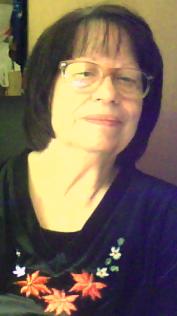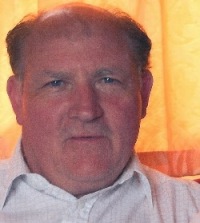
By
Melinda Cohenour
Following the theme of documenting my own
stories as I near the zenith of life, I've chosen to relate this story
which ties together so many threads of the fabric of my memories.
Places, people, music - themes intertwined. I've long held a belief that
one of God's 'mysterious ways' includes His way of introducing folks
who will have an impact (great or small but there, nonetheless) on our
life. In my theory, the first moment a person enters your consciousness -
that first moment of awareness, maybe a lingering glance, perhaps
something elusive that grabs your attention whatever form it takes -
that initial awareness foretells a future interaction or even INTERWOVEN
chains of events. The longer the glance or the greater the initial
impact, the more complex will be your future shared HAPPENINGS. I will
revisit this belief hopefully in a future column because there have been
a few amazing such miracles in my long life. Such is the story of Bob
Brunson and the Rubaiyat and our complex friendship through the years.
Recently Bob and I shared internet stories about that well-loved place
and time in our lives. Bob wrote back with what I believe to be the epic
summation of that moment in time:
"The article captures the essence, (a bit hyperbolic)
Nevertheless, to some degree we all knew we were watching music history
being made. It was the proverbial lightning in a bottle, and sadly,
won't be repeated. Luckily, we got to watch some of it happen."
The Rubaiyat, Dallas, Texas.
(My personal Magic Carpet)
My dear friend Bob Brunson introduced me to the Rubaiyat in the very
early 1970's or perhaps even 1969. Bob had been in a recently ended
long-term romantic relationship with a lovely young lady and they had
maintained a good friendship. She was at that time engaged to an old
friend of mine from Monahans High School - Ray Pope. Ray's daddy was one
of our football coaches. It was a serendipitous event when my sister
Noralee and a girlfriend of mine joined me for burgers at Adair's, a
very popular hole-in-the-wall hangout in Dallas, originally located on
Cedar Springs. (Adair's history in link at end of column). We were
laughing and joking with a table of guys near us who asked where in the
world we got our deep Texas drawl. My response, "Out in a little piece of Heaven in the Sandhills named Monahans!" From somewhere in the huge crowd was heard, "Did I hear MONAHANS? WHERE ARE YOU MONAHANS!"
It was Ray Pope. We shared our table with Ray, said our Hellos and
exchanged phone numbers and that began a High School reunion of sorts as
Ray and I shared our Monahans alumni pals' Dallas info. Soon Ray
introduced me to his girlfriend and they decided I had to meet Bob
Brunson. What a wonderful friend Bob became. A dear, funny, talented,
caring, beloved friend for life.
Bob told me the best music venue in Dallas (and maybe in the world) was The Rubaiyat. He promptly took me to see a favorite of his, Mike Williams (Is There a Heaven for Balloons?)
The Story of the Rubaiyat may be read by clicking the link below this column.
There I saw Steve Martin, before he was a name, do his comic
skits including the phone monologue and the arrow through the head bit.
Who could possibly know decades later Steve and my phenomenally talented
sister-in-law Patti Cohenour would become friends and even share a
marquee. Patti was cast in the premiere production of the musical Bright Star which Steve Martin co-created with Edie Brickell. This collaboration capped a long-time friendship with Steve.
Patti was the first alternate to Lady Sarah Brightman when
"Phantom of the Opera" burst upon Broadway to worldwide acclaim and her
arias were valued over even Ms. Brightman's by many critics. Patti
performed the lead when Phantom played in Canada as well as in London
where the musical was viewed by the Queen of England. This was but one
of Patti's starring roles on Broadway albeit, undoubtedly, the most
famous.
Also at the Rubaiyat I became acquainted with Michael Martin
Murphy (way before he had to add Martin as his middle name because
professionally ASCAP already had an acting member named Michael Murphy),
Ray Wylie Hubbard ... Three Faces West, both Dan McCrimmon and Steve
Fromholz of Frummox (each of whom would later be separately named
Poet Laureate by the State of Texas), B. W. Stevenson (my personal
nickname for my "lil brother" was Chuckles, which he pretended to hate
but secretly loved. We became close friends. He turned to me for advice
when Steve McQueen happened to show up on a motorcycle at the little
Austin club where he was playing and wanted to sign him to do the music
for his next film, The Getaway. Sweet BW thought I knew
everything, bless his heart. I deeply appreciated his friendship but
when he called, I, of course, advised him to get a good lawyer and to
protect his publication interests.)
(Another side story of interest here: I first met B. W. and
his harmonica playing friend Michael Siegfried Raphael playing together
informally at the Rubaiyat. They were former high school buddies.
Michael Raphael (who always went by Mickey and we nicknamed "Mickey
Mouth,") would later join Willie Nelson's band and make musical history.
There's hardly a recording artist or group that hasn't shared their
stage or recording studio with Mickey Raphael, rock, jazz, folk,
country.... he's played for all musical genres! Along the way, Mickey
Raphael would meet Ali MacGraw who was divorced from Steve McQueen.
Mickey and Ali never married but shared many years happily together.
(More about Mickey "Mouth" Raphael at the link below column.)
He also told me as we sat outside the apartments managed by
Allen Damron that his late father had come to him the night before, sat
on his chest and told him to wake up as he had to tell him something
important.
Then Chuckles said, "Daddy says I'll never see 39. I'm gonna die at 38 of an infected heart."
He did - following open heart surgery a staph infection of his heart culminated in his death.
(Allen Damron became another lifelong friend. I cherish our
last email exchanges during his last years in Terlingua before his death
in 2005. I've included a link to his biographical information below.)
I just located an old post in Facebook that included a
comment of mine memorializing some of the very memories I've mentioned
in this column (shared in next paragraphs):
"Frummox",
Jerry Jeff Walker, Michael Martin Murphy, B W Stevenson and Mickey
"Mouth" Raphael (fresh from high school and a team at that time before
Willie Nelson discovered the incredible harmonica talent of Mickey),
Three Faces West, Russ Kirkpatrick, marvelous entertainment from the
'60's and '70's appeared there. What wonderful memories.
A sweet gem
that appeared below this of mine posted Aug 9, 2016, was a comment made
by my dear, dear friend Angela Blair (elder sister and best friend,
manager, strongest supporter and essential organizer and marketing pro
of Steve Fromholz). Angela wrote: "Those were the days my friend!" to which I replied: "Feeling a bit nostalgic today, Sis. Oh! To relive those days, complete with all our beloved friends and family."
My long-term relationship with Steve Fromholz began with the first time I heard Frummox
... Steve introduced himself after the first set. We made the after
hours circuit that evening, the first of many many years of memorable
times that evolved from that first night together. Steve and Travis
Holland and a few more band members crashed at my apartment once when
rooms in Dallas simply could not be obtained due to some huge
convention. The guys, as usual, engaged in an impromptu jam. They firmed
up some lyrics of Everybody's Going On The Road and started a
couple of new song ideas. (I'd be remiss if I failed to provide a link
or so to Steve performing a few of his songs. See below)
Travis Holland was a very cherished friend of Steve's. Steve
credited Travis with teaching him how to "really play" guitar. Travis
was the master of deadpan, low-key humor (or was it just Travis being
Travis?) Steve told of them going to a restaurant whose claim to fame
was a menu full of egg dishes: Benedict, scrambled, omelettes galore,
fried sunny side up or over easy or laced. Waitress asks Travis "And how do you like your eggs sir?"
Travis: "Jes fine, ma'am, jes fine.'
My favorites of all Steve's songs are "Song for Steven Sills"
and his famed incredible Texas Trilogy. Follow the links to hear him
perform these songs.
I still mourn his loss.
So many of these friends have passed beyond the veil; but my
memories of so many, many shared moments will live on bringing light and
love and music and laughter into my days.
Penned with love.
Links to introduce you to my friends and world during those early adult years whose memories enrich my life to this day.
The Rubaiyat:
The Story of the Rubaiyat Club, the Birthplace of Texas Music - D Magazine
scattershooting: the RubaiyatThis second link mentions Russ
Kirkpatrick who actually wrote a song about a shared memory of a prior
life we believe we shared along with Bill Moss (fabulous black folk
singer who actually saved my life once ... for another memory one day).
Russ and I dated awhile...
scattershooting: the Rubaiyat
History: Adair's Saloon
Adair's Saloon
Mickey Raphael Actually Played Iconic Harmonica Solo on Motley Crue’s “Smokin’ In The Boys Room” here:
“Smokin’ In The Boys Room” - Saving Country Music
More about Mickey "Mouth" Raphael here:
Mickey Raphael - Wikipedia
B. W. "Buckwheat" Stevenson
A Live Performance video:
His story:B. W. Stevenson - Wikipedia
B. W. Stevenson - Wikipedia
Stevenson, Louis Charles \[Buckwheat, B.W.]
Stevenson, Louis Charles [Buckwheat, B.W.]
Very nostalgic video:BW on stage when Steve Fromholz, Rusty
Wier, and Mickey Mouth Raphael drop in for a rousing, crazy unrehearsed
performance. Today only Mickey Raphael is still here. We have lost BW,
Steve and Rusty ... Three of my crazy, sweet, talented, fun loving
friends. Not the most polished but certainly one of my treasures videos.
BW on stage when Steve Fromholz, Rusty Wier, and Mickey Mouth Raphael drop in for a rousing, crazy unrehearsed performance.
And can't leave out this one. Five of BW's best songs
Five of BW's best songs
Allen Damron
Damron, Allen Wayne
Steven Fromholz - Wikipedia
Steven Fromholz - Wikipedia
Instagram share by a fan who wrote:
Willie's mid-70s recording of his "I'd Have to be Crazy" bought
Lamborghinis for Steve's grandkids, and made it OK -- albeit, sad --
that most of the rest of the world never caught on to how great he was.
He has the Texas Trilogy already but I thought this would be another
nice triple take on his genius.
((Usual small-print: All rights reserved by Steve, his publishers and
his record companies. I am making no attempt to derive $$$ benefit from
posting this, only trying to introduce others to what some of us already
know, and maybe even make the poor guy a few more bucks for all the joy
he's given us.)
Instagram share by a fan
Frummox(Steve Fromholz and Dan MacCrimmon) performing Man With the Big Hato. Steve when I first met him.
Frummox(Steve Fromholz and Dan MacCrimmon) performing Man With the Big Hato
Frummox: Here to There, 1969 feat.
Frummox: Here to There, 1969
Attachments Area:
Preview YouTube video B.W. Stevenson and Friends (Live) 1974 -
Ritz Theatre, Corpus Christi, TXPreview YouTube video B.W. Stevenson and
Friends (Live) 1974 - Ritz Theatre, Corpus Christi, TX
Preview YouTube video 5x B. W. Stevenson ( The Best Of
Internacional Music )Preview YouTube video 5x B. W. Stevenson ( The Best
Of Internacional Music )
Preview YouTube video Steve Fromholz -- Road, Bears, Alone
trilogy.wmvPreview YouTube video Steve Fromholz -- Road, Bears, Alone
trilogy.wmv
Preview YouTube video Frummox - Man With The Big Hat \[1969]
Preview YouTube video Frummox - Man With The Big Hat \[1969]
Preview YouTube video Frummox - Here to There (1969) - feat.
Steven Fromholz and Dan McCrimmonPreview YouTube video Frummox - Here to
There (1969) - feat. Steven Fromholz and Dan McCrimmon
Click on author's byline for bio and list of other works published by Pencil Stubs Online.









